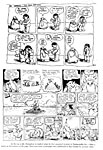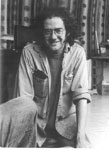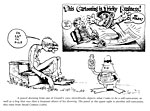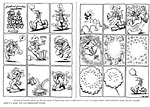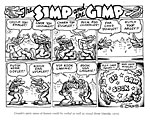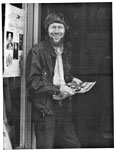THE LONELY HEARTS CLUB BAND
The Summer of Love, Robert Crumb, and the Birth of Underground Comix
During
that storied hippie Summer of Love in 1967, an estimated 75,00 young Americans
put a flower in their hair and went to San Francisco, and as soon as they hit
the City by the Bay, they gravitated to hippie Mecca, "the Haight,"
where they started getting better all the time. On any late afternoon that summer, Haight Street between Central
and Shrader swarmed with humanity, both on foot and in cars. Vehicles moved at a dead crawl because the
streets were jammed, sometimes with pedestrians who chanted "Streets are
for the people" as they walked beatifically into intersections without
regard for four-wheeled traffic. The
scene was part Old Calcutta and part carnival midway. The teeming throngs of mostly young people were dressed in Indian
paisley prints and T-shirts, Levis and boots and pseudo-Western garb, scraps of
Army and Navy surplus, and remnants of by-gone fashions culled from local
thrift shops; some wore beads and tinkling anklet bells and buttons with
cryptic messages on them ("Frodo Lives," "Haight Is Love,"
"Freak Freely"). A few of the
milling multitude passed out flyers and broadsides or, on Fridays, sold copies
of the radical underground paper from across the Bay, The Berkeley Barb, or the milder neighborhood publication, The Oracle, which, by summer, was being
printed in a rainbow of changing hues that rendered it all but unreadable;
others along the street unabashedly hawked drugs ("Acid? Speed?
Lids?"). Some gathered around the
periodic Grayline tour bus and held mirrors up to the windows for the tourists
to see themselves in. (An ironic
exercise since most of those in the street were themselves visitors to the
vicinity rather than residents.) A few
carried tiny bells or tambourines or feathers or bits of fur that they would
hold in the faces of other stoned trippers to "blow their
minds." Teenie-bopper runaways
with dirty faces hoped for a little help from their friends and begged for
spare change.
It was street theater, a
participatory art form peculiar to the sixties, particularly to the psychedelic
community in the Haight, which Charles Perry, an associate editor of Rolling Stone, once described as "a
perfect theater, a large territory full of stoned people making the scene and
vaguely waiting for something to happen." The world's first Be-In had been held earlier in the year (January 14)
in the polo grounds at the Golden Gate Park a few blocks west of the Haight; it
was a "happening" at which the only event of note was simply the
presence of people, amply entertained by themselves and a selection of speakers
and rock bands. It was the kind of thing
for which the Haight was, by then, renowned.
"The Haight" was hip for
the Haight-Ashbury District, a huddle of rundown Victorian houses and somewhat
seedy storefronts at the east end of Golden Gate Park and separated from the
rest of the city by the wooded hills of Ashbury Heights. Although the population was chiefly Poles
and Czechs who had lived there since before World War II, students at the
nearby University of San Francisco had begun to infiltrate the neighborhood a
few years before to take advantage of the low rents, and an art colony was in
full flower. By 1967, there was also a
conspicuous infestation of dope-using drop-outs and hippies. For many of the latter, life revolved around
periodic psychedelic rock dance concerts and the musicians and the poster
artists whose works celebrated the dances they advertised. The first of these dances had been sponsored
by the Family Dog in October 1965 as "A Tribute to Dr. Strange." That a Marvel Comics character should be so
honored was not, at the time, remarkable: Ken Kesey (of “Cuckoo Nest” fame), an early apostle of acid, had toured
the vicinity frequently, proclaiming the heroism of everyday life and asserting
that the costumed superheroes of Marvel Comics had as much to say about life as
most comtemporary literature. And his
Acid Trip retinue included the Merry Pranksters, who dressed in costumes like
superheroes.
The dances at the Fillmore and
Avalon were conceived and staged as participatory art. The stoned crowd circling the dance floor chanted
and sang and painted each other's bodies with bright colors, blew whistles and
flutes, vibrated in the strobe lighting, and gawked intensely at the walls and
ceiling against which light shows displayed changing colors that throbbed in
tune with the music's beat. The sound
overwhelmed all the senses, enhancing the drug-induced oceanic feeling that
"all is one" and that, therefore, everyone was "on the same
trip." It was, they believed, a
trip of love, peace, beauty, and freedom. Others might observe (more-or-less correctly) that the trip featured
chiefly drugs and sex and rock-and-roll parties all night long, but even so,
the psychedelic community was an astonishingly peaceful one, compared, say, to
the beer-guzzling orgies of college students on spring break at Fort
Lauderdale.
The posters that announced the times
and places of the dances had become objets d'art in themselves. In defiance of conventional marketing
custom, content on the posters was subordinated to design. Early poster artists Wes Wilson and Stanley
"Mouse" Miller became adept at using bold colors and abstract,
mushrooming, twisting shapes that incorporated pop images and virtually
undecipherable lettering into the same design (creating a product that
"made sense only when you were stoned," according to Perry). The Print Mint, initially founded by Don
Schenker as a framing and printing establishment for fine art reproductions,
soon concentrated on producing dance posters and then began commissioning
artists to do posters in a satiric vein. Before long, the Print Mint would be publishing yet another satiric
product, comic books.
Robert Crumb arrived in the Haight
in January 1967, fleeing a wife and an unwanted marriage and a stultifying job
at American Greeting Cards in Cleveland. There he'd been taking LSD and using a little pot for a couple of years,
so when he saw some dance posters from San Francisco, he knew the source of the
poster artists' inspiration. And he was
primed for what he called "the wild and wacky hippie scene at its high
noon of acid-induced euphoria." Guilt-ridden about his wife Dana, he sent for her after three weeks, and
they took an apartment in the Haight; she worked, and he "hung out,"
smoking dope and listening to rock records and drawing drug-inspired comic
strips in his sketchbooks.
He also hitch-hiked back and forth
across the country, and it was perhaps on a springtime stop in his hometown,
Philadelphia, that he met Brian Zahn, who was about to publish an underground
newspaper that he called Yarrowstalks. Zahn took one of Crumb's cartoons, and Mr.
Natural saw print in the first issue of the paper, dated May 5, 1967. About that time, Crumb met Don
Donahue at the home of a friend. Donahue had seen Crumb's work in the underground newspapers Yarrowstalks and The East Village Other and had tried in vain to locate the
cartoonist. Crumb had some of his Zap pages with him, and when Donahue saw
them, he eagerly offered to publish the comic book. Donahue traded his hi-fi tape recorder to an old hipster printer
named Charles Plymell in exchange for 5,000 copies of what became Zap Comix No. 1. It was a uncomplicated production: two colors on the cover; all black and white
inside. Its simplicity kept its cost
low; it set the mold for the genre. "The first issue was printed in
February 1968," Crumb recalled. "We folded and stapled all 5,000 copies ourselves and took them out
and sold them on the street out of a baby carriage. At first, the hippie shopkeepers on Haight Street looked down
their noses at it— ‘A comic book? No, I
don't like comic books.’ It looked just
like a traditional comic book. It had
none of the stylings of your typical psychedelic graphics—the romantic figures,
the curvy, flowing shapes. It took a
while to catch on."
But not as long as Crumb implies. Responding to demand, Donahue (calling
himself Apex Novelties) did a so-called second printing of the first issue
within a month or two in order to replace the inventory that had been destroyed
in a fire at his establishment. (It was
actually more of a second edition than a second printing because Donahue added
four more pages of Crumb material, producing a 28-page magazine.) Donahue also printed Zap Comix No. 2 in June, but Crumb was unhappy with the quality of
the printing, and Moe Moscowitz of Moe's Books in Berkeley put up money for the
Print Mint to do the later runs of this issue and all subsequent issues. Zap No. 2 included contributions from two poster artists, Victor Moscoso and Rick
Griffin, and another cartoonist, S. Clay Wilson. By late fall, Crumb comix had become popular enough to stir up a
flurry of publishing activity. In
December, using photocopies Crumb had made of the "first issue" that
he'd sent to Philadelphia, the Print Mint published Zap Comix No. 0 and, at about the same time, Zap Comix No. 3, which added Gilbert Shelton to the roster of Zap regulars. Of the Zap crew, Wilson
probably influenced Crumb the most.
Wilson had drifted into Crumb's
apartment one day from Nebraska. An art
school graduate, Wilson saw himself as an art outlaw whose function was to use
his art to puncture the "booshwah" balloon, to strip "the mass
delusion" from the eyes of the American middle class. Wilson was a heavy drinker, preferring wine
and beer, and Crumb went drinking with him, and they talked into the
night. "A seething, visionary
kinda guy, Wilson was very inspiring to be around in those days," Crumb
wrote. "I learned a lot from
Wilson. He had evolved and articulated
his artist-rebel thing to a high degree. He lived the role. By comparison,
my conception about what I was up to as an artist was murky, unformed. I was coming from a rather more conventional
cartoonist-as-entertainer background. We had long discussions about what this work we were doing was all
about. Wilson once said to me, ‘Fuck
entertaining the masses, Crumb! You're
just feeding the hungry dog.'"
Wilson's contribution to Zap Comix No. 2 was violently different
from Crumb's good-natured big-foot material. Wilson drew stories about bikers and pirates and lesbians and all kinds
of unsavory demonic freaks. And he drew
them as grotesque gargoyles, ugly and malformed and repulsive—covered with
blemishes and scars, warts and unruly hair. His graphic style was raw and uncompromising, and his characters were
relentlessly brutish, violent savages who stabbed and chewed each other to bits
whenever they weren't committing bizarre sex acts. Wilson held nothing back, made no concession to social convention
whatsoever; he relished offending every civilized sensibility. And he had an effect on Crumb.
"Getting involved with these
other artists who had very strong personal visions of their own threw me off my
track," Crumb said. "For
better or worse, the influence of Wilson and [Los Angeles poster artist Robert]
Williams began to show in my work. I,
too, became more of a rebel. I cast off
the last vestiges of the pernicious influence of my years in the greeting card
business [and] let it all hang out on the page—the raging Id. Seeing what Wilson and Williams had done
just gave me the last little push I needed to let open the floodgates. Blatant sexual images became a big thing,
still happy and positive at first—a celebration of sex. [But as time went on], I moved further and
further away from mass entertainment. The sexual element became increasingly sinister and bizarre."
Crumb and Wilson collaborated in the
fall of 1968 on another comic book. Called Snatch Comics, it dealt
explicitly with sex. Crumb and Wilson
showed penises and penetration, cunninglingus and fellatio. Not since the infamous home-made eight-page
Tijuana bibles of the 1930s and 1940s had sex acts been so graphically
depicted. Graphically and
joyfully. These pages are infused with
a giddy glee; even Wilson's contributions are cheerful evocations of sexual
fantasies rather than his typically brutal confrontations. Donahue agreed to publish the book on the
condition no one would know he printed it. His association with Crumb was coming to a close now that Zap Comix had been taken over completely
by the Print Mint (which would venture even further into comix publishing that
fall, launching the tabloid newspaper Yellow
Dog Comics to which Crumb contributed).
Coincidental with the production of
material for the first issue of Snatch, Crumb went to New York and made a startling discovery. He was a celebrity. And his fame was not confined to the
counterculture enclaves served by the underground papers he'd cartooned for or
by the comic books. He was photographed
by Life (although the article never
appeared). "I had suddenly become
a phenomenon, another hippie counterculture personality—Mr. Keep-on-Truckin',
Mr. Zap Comix. If you were a hip
college student, you had to have a Zap comic next to your dope stash. I didn't
have any money but I had glory! I was America's
best-loved underground cartoonist."
Just as head-turning as this
overnight fame was his sudden success with women. In New York, he met other underground cartoonists—Spain Rodriguez
and Kim Deitch and Art Spiegelman—and one night, Spiegelman brought his date
and another girl to a restaurant dinner with Crumb. Suddenly, Crumb said, he realized that the extra girl was being
"presented" to him. And that
she would be completely accommodating. "I didn't have to say or do anything to earn this wondrous
creature's favors," he wrote. "She was mine for the taking simply because I was Thee Famous, Thee
Ultra-hip R. Crumb. That was it. If I wanted the chick, I could have her. So
this was fame. Incredible—the girl was
stunningly cute—a baby-faced seventeen-year-old. I stared at her speechless. Never in my wildest trembling dreams—I was twenty-five, and never in my
life had a girl this attractive, this perfect, ever looked at me twice."
Now, he was to learn, stunningly cute girls of this sort would flock to him,
offering their favors without being asked.
Crumb did not consider himself
physically attractive to women. Beak-nosed and slightly buck-toothed, he was tall, alarmingly skinny,
and wore glasses. The classic
adolescent nerd. Born in 1943 in Philadelphia while
his father was serving in the Marines during World War II, he was the third of
five children. The second born,
Robert's older brother Charles, was the leader of the troupe, devising games
for them all to play. He and Robert
very early discovered a common interest in comic books, and they began writing
and drawing their own single-copy comics, imitating the animal characters they
found in Walt Disney's Comics &
Stories (Carl Barks' ducks), Dell's Animal
Comics (where Walt Kelly dominated the pages), New Funnies (Andy Panda), and Terrytoons (Mighty Mouse, Gandy Goose, and Heckle and Jeckle). Their method in creating these "two-man comics" was
unique: they worked together, each
drawing and dialoguing his own character to which the other made his characters
respond. It was an absorbing amusement
but it isolated them from other children; for the time being, they lived
happily in their own fantasy world.
In 1959, the brothers did a story
called "Cat Life" in which a cat named Fred starred; Robert did the
hero, and Charles did the villains in the story. In the next cat story, Fred stood up and wore clothes. And he changed his name to Fritz. Robert was comfortable working with animal
characters: "I can express
something with them that is different from what I put into my work about
humans," he wrote to his friend Marty Pahls at about this time; "I
can put more nonsense, more satire and fantasy into the animals. They're also easier to do than people. With people I try more for realism, which is
probably why I'm generally better with animals." He would continue drawing
Fritz the Cat for years and would come to despise the character.
By 1960, after he graduated from
high school, Charles had lost interest in cartooning. Robert kept on drawing, focussing on alter ego characters that
represented "the inner me ... with the emphasis on the lovelorn side of my
nature." He finished high school in 1961 but stayed at home, drawing,
until the fall of 1962, when, prompted by an invitation from Pahls, he went to
Cleveland and soon found a job with American Greeting Cards. Although his memories of his training period
are tinged with a measure of bitterness about the often arduous factory-like
mechanics of its operation, Crumb learned a great deal and developed facility
with a variety of drawing tools and techniques. By the summer of 1963, his doodling on scraps of paper at his
drawingboard had attracted the attention of Tom Wilson. Wilson, who would later create the put-upon
cartoon character Ziggy, was then head of the Hi Brows department, which
produced the company's new line of wise-cracking cards. That fall, Wilson had Crumb transferred to
Hi Brows where creativity was encouraged and rewarded, and Crumb began to enjoy
his work more.
Pahls and Crumb rented the third
floor of a rooming house on East 115th Street, and the two of them cruised
thrift stores and other second-hand outlets for old 78 rpm records, magazines,
newspapers, advertisements, posters—any and all artifacts of American popular
culture 1920-1940. And Pahls encouraged
his roommate to hang out with him at local bars frequented by co-eds from
nearby Case-Western Reserve University and highschool girls visiting from
Cleveland Heights. But Crumb was still
a virgin in the spring of 1964 when he met Dana Morgan, an eighteen-year-old
Cuyahoga Community College student with middle-class parents in Cleveland
Heights. She had seen some of his
drawings and loved them. Crumb still
considered himself "a freak, a four-eyed, star-crossed, skinny loner, with
a message impossible to communicate to an uncaring and uninterested world"
according to Pahls, and he was therefore easy prey for a girl like Dana. He was immediately smitten by her plump
"robust" figure ("big legs and all that," he said) and
"beautiful Krishna-like face with big oval brown eyes." And Dana
wanted Crumb. At first he rejoiced in
their relationship (which was sexually consummated only after a two-month
courtship), but before long, her possessiveness began to suffocate him. He fled. Applying to Wilson for a leave of absence, Crumb went to New York that
summer.
In New York, he sought out Harvey
Kurtzman, whose Mad had stimulated
some of the "two-mans" of his youth. Kurtzman was then producing Help! for Jim Warren, and he put Crumb to work assisting Terry Gilliam (later of
Monty Python fame) in production chores. And he bought "Fritz Comes on Strong," a two-page episode in
which Fritz disrobes his date, apparently intent on having sex with her. He removes one article of clothing at a time
(thereby prolonging the suspense), and when she is at last naked, the cat
suddenly behaves like a grooming animal: "Now be patient, my sweet," Fritz murmurs, "—them little
fleas are hard t'get a hold of."
Crumb also found work in a Greenwich
Village quick-draw portrait gallery, a job that moved to the Atlantic City
boardwalk for the Democratic National Convention that summer. There, suddenly, Dana appeared and hauled
him back to Cleveland and marriage. Then they went to Europe. Crumb
arranged a freelance-by-mail contract with American Greetings: Wilson would send him card ideas, and he'd
send back finished art. At about $25 a
card, it would be enough to keep the couple afloat. They spent the winter in Switzerland, and Crumb filled sketchbooks
with comic book stories, many starring Fritz. The cat was Crumb's stand-in: he
was successful where Crumb was not. He
was a glib-talking ladies man and bon vivant, master of any situation in which
he found himself (particularly those involving the female of the species). But Fritz was flawed: he was a self-centered hedonist and
prankster without the slightest moral or ethical qualm. He was, as Pahls said, "a poseur,"
a phoney. And although Fritz's
posturing was taken seriously by all those around him, Crumb always arranged a
comeuppance, keeping his egotistic protagonist in hot water. It was, psychologically speaking, the
cartoonist's revenge upon those more socially adept than he: he may have envied their success, but by
making it clear that their attainments were founded on insincerity and blatant
self-interest, he demonstrated that those he envied were not as worthy as, say,
he was.
Crumb's graphic style was forming,
too. Using the Rapidograph drafting pen
that he'd learned about while in training at American Greetings, he gave his
outline drawings texture and volume with shading techniques that became
increasingly intricate.
Crumb and Dana returned to Cleveland
in the spring of 1965, and Crumb resumed his work at American Greetings. Shortly thereafter, he took LSD for the
first time; then marijuana. And his
marriage, never quite stable (based, as it was, more upon Dana's desire than
Crumb's), began to fall apart. He
started seeing other women. Then in
August, he responded to a call from Kurtzman, who wanted him to replace Gilliam
on Help! But when he and Dana arrived in New York, Warren had just pulled
the plug on the magazine. Kurtzman,
feeling responsible for Crumb being in New York, tried to find work for
him. He also invited him to his house
for dinner frequently. "Kurtzman
was my hero," Crumb said. "Hanging out with him was very instructive. He showed me a lot of techniques and told me
a lot about the commercial art business, how it worked and what to look for and
the pitfalls. He gave me a lot of good
advice. He headed me in the right
direction. He's probably the only
person in my whole life who was a good teacher. The only one. The only
person I ever learned anything useful from." Crumb didn't work out as an
assistant on Little Annie Fanny, but
he did work for Topps bubblegum cards, a Kurtzman referral. This led to assignments on several projects
being launched privately by the head of Topps' creative department, Woody
Gelman, under the imprint of his Nostalgia Enterprises.
Crumb and Dana moved from their
Yorkville studio apartment to the East Village in late 1965. Always a bohemian haven, the Village was now
making room for the last of the beatniks and the first of the hippies by
expanding eastward into the low-rent threadbare district around Tompkins
Square. Crumb, taking LSD more and more
often, continued to draw his own comics in sketchbooks. And then he picked up a copy of the East Village Other, an underground
newspaper, in which he saw his first underground comic strip—Bill Beckman's Captain High, a cartoon celebration of
drugs. Dana found a job in the pharmacy
at Roosevelt Hospital and brought home handfuls of methadrine tablets. Friends from Cleveland moved to New York,
and they spent evenings at the Crumbs', dropping acid and popping pills and
talking. Among the friends was a girl
with whom Crumb had enjoyed an affair before coming to New York; they resumed
their relationship. Dana went back to
Cleveland. A few weeks later, Crumb left for Chicago, where he lived with Marty
Pahls. While there and under the
influence of some "fuzzy" acid he'd taken in New York, he spent days
drawing in his sketchbooks, creating the entire cast of characters that would
populate his comics for years thereafter—Mr. Natural, Flakey Foont, Schuman the
Human, the Snoid, Eggs Ackley, the Vulture Demonesses. "It was a once-in-a-lifetime
experience," he wrote, "—like a religious vision that changes
someone's life, but in my case it was the psychotic manifestation of some grimy
part of America's collective unconscious."
Later, Crumb would attribute his emergence as a cartoonist to the "fuzzy" LSD trip (and to taking LSD generally). "I could show you in my sketchbooks where that period starts," he told Gary Groth, "when I was in that fuzzy state, and how my art suddenly went through this change, this transformation in that couple of months." And here are samples of the best Crumb galoot comics.
AT THIS POINT IN OUR NARRATIVE, we interrupt (never to resume) for a commercial: the
foregoing is taken nearly verbatim from the ninth chapter of one of my books, The Art of the Comic Book, about which
you can read more by clicking here. In the book, I examine Crumb’s work
in some detail; you can get a hint of that by clicking here, which will
take you to another entry in the Hindsight department, one devoted entirely to
Crumb. But in the book, we go from the Summer of Love and Crumb’s debut to the
earliest manifestations of underground cartooning—with Frank Stack, who
produced what many claim is the first underground comic book, The Adventures of Jesus, in 1962.
Actually, it was Gilbert Shelton who published it, eight stapled-together sheets of paper on which
Shelton had duplicated some of his favorite “Jesus” cartoons by Stack. Stack
tells the tale in The New Adventures of
Jesus: The Second Coming, the definitive and complete compilation of Jesus
cartoons published by Fantagraphics in 2006 (160 7.5x10-inch pages, $19.95).
Following Shelton’s wildcat publication of Jesus cartoons, Stack contributed
more in the same vein to several underground comix over the years, and in 1979,
Rip-Off Press collected many of these fugitive parables in The New Adventures of Jesus by Foolbert Sturgeon, the pen-name
Stack was employing at the time. The Fantagraphics tome reprints all of these
and adds other fugitives to the anthology to make it “complete.” Stack winds it
all up with a prefatory history of the invention of the character and an
epilogue about his so-called experience with religion. Raised in the Methodist
persuasion, he was a regular church-goer until he went to college, whereupon he
lapsed and never came back. “The basic idea of [the Jesus cartoons],” Stack
writes, “came from a chapter in The
Brothers Karamazov called ‘Dimitri’s Dream’ or ‘The Grand Inquisitor’ in
which Christ returns [to earth], only to be arrested and imprisoned.” Smitten
by this notion, Stack imagined Jesus coming back and being ostracized by
conventional society because, with his long hair, beard and robe, he looked
like a hippy.
Much of my descriptions herein of
life on the streets in San Francisco’s Haight are taken (sometimes
word-for-word) from The Haight-Ashbury: A
History, by Charles Perry. I am also indebted to comics historian Clay Geerdes who cheerfully checked the
factual accuracy of the chapters in my book having to do with underground comix
and cartoonists. Living in Berkeley,
Geerdes began in October 1973 to produce a newsletter about underground comix
and related matters. At that time, he
also started a journal in which he recorded the day he picked up each new
underground comic book. "I know
exactly when this or that book came into the Print Mint warehouse in Berkeley
or to Last Gasp in San Francisco," he says in "The Dating of Zap
Comics," an unpublished manuscript (1994 copyright by Clay Geerdes) from
which I quoted with permission in the book. Although Geerdes was not keeping
his journal during the formative period covered on these pages, his interest in
underground cartooning grew over the years, and he tried to get to know as many
of the cartoonists as possible. In
conversations with them, he picked up knowledge of the early history of comix.
When Clay encountered the version of the Haight in 1967 that I appropriated from
Perry, he said it was mostly fictional. Clay had lived in the Haight and said
Perry’s account was the invention of over-active imagination. But I left my
description pretty much as I’d produced it with Perry at my elbow. In the
summer of 1967, I was in New York, attending graduate school at New York
University and living in the Village. What I found in Perry coincided with my
experiences in the Village that summer—not exactly, but close enough. The
Summer of Love was in San Francisco, but the Village wasn’t necessarily having
a summer of hate (or of “Haight,” to belabor the pun). I found plenty in Perry
that reminded me of my summer in 1967 on the other coast, and so I left as much
of it as echoed the Village as I could, adding, occasionally, by dipping into
my own recollections of the hippie phenomena of that time.
Clay Geerdes was a notable photographer, by the way, and
a year after his death (from cancer in
July 1997), a collection of his photos of undergrounders was published by
WordPlay (a device of Malcolm Whyte, or I miss my guess). These were flat-out,
full-page portraits in black-and-white, each one faced with a brief
biographical note topped by a sample of the cartoonist’s work. Entitled The Underground Comix Family Album, it
may be one of the best records of the fabled era of underground comix. The
photos were all taken, probably, in the 1970s, when Clay first got ferociously
interested in undergrounders, so they show us what the denizens looked like—how
they dressed, how they grew their hair, and so on. The I miss Clay, and thumbing through his photographs in this book reminds me just how much. One of these times, I’ll revive the remembrance of him that I concocted as an obituary in that sad summer of 1997. Until then, here’s a photo of Clay and how he looked in those days of yesteryear.
|
||||
